*NURSING > QUESTIONS & ANSWERS > SOLVED!!! NR 509 COMPREHENSIVE REVIEW OF JARVIS 7TH EDITION CHAPTER 22 QUESTIONS (Musculoskeletal Sy (All)
SOLVED!!! NR 509 COMPREHENSIVE REVIEW OF JARVIS 7TH EDITION CHAPTER 22 QUESTIONS (Musculoskeletal System: Physical Examination & Health Assessment)
Document Content and Description Below
SOLVED!!! NR 509 COMPREHENSIVE REVIEW OF JARVIS 7TH EDITION CHAPTER 22 QUESTIONS (Musculoskeletal System: Physical Examination & Health Assessment) ◇This material contains comprehensive summary of ... information in the form of great test questions with descriptive answers helpful for exams study. Thorough Review of Jarvis 7th Edition Chapter 22 Questions. All the best Champions! ______ MULTIPLE CHOICE 1. A patient is being assessed for range-of-joint movement. The nurse asks him to move his arm in toward the center of his body. This movement is called: a. Flexion. b. Abduction. c. Adduction. d. Extension. ANS: C Moving a limb toward the midline of the body is called adduction; moving a limb away from the midline of the body is called abduction. Flexion is bending a limb at a joint; and extension is straightening a limb at a joint. DIF: Cognitive Level: Understanding (Comprehension) REF: p. 578 MSC: Client Needs: Physiologic Integrity: Physiologic Adaptation 2. A patient tells the nurse that she is having a hard time bringing her hand to her mouth when she eats or tries to brush her teeth. The nurse knows that for her to move her hand to her mouth, she must perform which movement? a. Flexion b. Abduction c. Adduction d. Extension ANS: A Flexion, or bending a limb at a joint, is required to move the hand to the mouth. Extension is straightening a limb at a joint. Moving a limb toward the midline of the body is called adduction; abduction is moving a limb away from the midline of the body. DIF: Cognitive Level: Understanding (Comprehension) REF: p. 578 MSC: Client Needs: Physiologic Integrity: Physiologic Adaptation 3. The functional units of the musculoskeletal system are the: a. Joints. b. Bones. c. Muscles. d. Tendons. ANS: A Joints are the functional units of the musculoskeletal system because they permit the mobility needed to perform the activities of daily living. The skeleton (bones) is the framework of the body. The other options are not correct. DIF: Cognitive Level: Remembering (Knowledge) MSC: Client Needs: General REF: p. 5774. When reviewing the musculoskeletal system, the nurse recalls that hematopoiesis takes place in the: a. Liver. b. Spleen. c. Kidneys. d. Bone marrow. ANS: D The musculoskeletal system functions to encase and protect the inner vital organs, to support the body, to produce red blood cells in the bone marrow (hematopoiesis), and to store minerals. The other options are not correct. DIF: Cognitive Level: Remembering (Knowledge) MSC: Client Needs: General REF: p. 577 5. Fibrous bands running directly from one bone to another that strengthen the joint and help prevent movement in undesirable directions are called: a. Bursa. b. Tendons. c. Cartilage. d. Ligaments. ANS: D Fibrous bands running directly from one bone to another that strengthen the joint and help prevent movement in undesirable directions are called ligaments. The other options are not correct. DIF: Cognitive Level: Remembering (Knowledge) MSC: Client Needs: General REF: p. 577 6. The nurse notices that a woman in an exercise class is unable to jump rope. The nurse is aware that to jump rope, one’s shoulder has to be capable of: a. Inversion. b. Supination. c. Protraction. d. Circumduction. ANS: D Circumduction is defined as moving the arm in a circle around the shoulder. The other options are not correct. DIF: Cognitive Level: Applying (Application) REF: p. 578 MSC: Client Needs: Physiologic Integrity: Physiologic Adaptation 7. The articulation of the mandible and the temporal bone is known as the: a. Intervertebral foramen. b. Condyle of the mandible. c. Temporomandibular joint. d. Zygomatic arch of the temporal bone. ANS: CThe articulation of the mandible and the temporal bone is the temporomandibular joint. The other responses are not correct. DIF: Cognitive Level: Remembering (Knowledge) MSC: Client Needs: General REF: p. 578 8. To palpate the temporomandibular joint, the nurse’s fingers should be placed in the depression __________ of the ear. a. Distal to the helix b. Proximal to the helix c. Anterior to the tragus d. Posterior to the tragus ANS: C The temporomandibular joint can be felt in the depression anterior to the tragus of the ear. The other locations are not correct. DIF: Cognitive Level: Understanding (Comprehension) REF: p. 578 MSC: Client Needs: Safe and Effective Care Environment: Management of Care 9. Of the 33 vertebrae in the spinal column, there are: a. 5 lumbar. b. 5 thoracic. c. 7 sacral. d. 12 cervical. ANS: A There are 7 cervical, 12 thoracic, 5 lumbar, 5 sacral, and 3 to 4 coccygeal vertebrae in the spinal column. DIF: Cognitive Level: Remembering (Knowledge) MSC: Client Needs: General REF: p. 579 10. An imaginary line connecting the highest point on each iliac crest would cross the __________ vertebra. First sacral a. b. Fourth lumbar c. Seventh cervical d. Twelfth thoracic ANS: B An imaginary line connecting the highest point on each iliac crest crosses the fourth lumbar vertebra. The other options are not correct. DIF: Cognitive Level: Remembering (Knowledge) MSC: Client Needs: General REF: p. 579 11. The nurse is explaining to a patient that there are shock absorbers in his back to cushion the spine and to help it move. The nurse is referring to his: a. Vertebral column. b. Nucleus pulposus. c. Vertebral foramen.d. Intervertebral disks. ANS: D Intervertebral disks are elastic fibrocartilaginous plates that cushion the spine similar to shock absorbers and help it move. The vertebral column is the spinal column itself. The nucleus pulposus is located in the center of each disk. The vertebral foramen is the channel, or opening, for the spinal cord in the vertebrae. DIF: Cognitive Level: Understanding (Comprehension) REF: p. 580 MSC: Client Needs: Physiologic Integrity: Physiologic Adaptation 12. The nurse is providing patient education for a man who has been diagnosed with a rotator cuff injury. The nurse knows that a rotator cuff injury involves the: a. Nucleus pulposus. b. Articular processes. c. Medial epicondyle. d. Glenohumeral joint. ANS: D A rotator cuff injury involves the glenohumeral joint, which is enclosed by a group of four powerful muscles and tendons that support and stabilize it. The nucleus pulposus is located in the center of each intervertebral disk. The articular processes are projections in each vertebral disk that lock onto the next vertebra, thereby stabilizing the spinal column. The medial epicondyle is located at the elbow. DIF: Cognitive Level: Applying (Application) REF: p. 581 MSC: Client Needs: Physiologic Integrity: Physiologic Adaptation 13. During an interview the patient states, “I can feel this bump on the top of both of my shoulders—it doesn’t hurt but I am curious about what it might be.” The nurse should tell the patient that it is his: a. Subacromial bursa. b. Acromion process. c. Glenohumeral joint. d. Greater tubercle of the humerus. ANS: B The bump of the scapula’s acromion process is felt at the very top of the shoulder. The other options are not correct. DIF: Cognitive Level: Applying (Application) REF: p. 581 MSC: Client Needs: Physiologic Integrity: Physiologic Adaptation 14. The nurse is checking the range of motion in a patient’s knee and knows that the knee is capable of which movement(s)? a. Flexion and extension b. Supination and pronation c. Circumduction d. Inversion and eversion ANS: AThe knee is a hinge joint, permitting flexion and extension of the lower leg on a single plane. The knee is not capable of the other movements listed. DIF: Cognitive Level: Understanding (Comprehension) REF: p. 583 MSC: Client Needs: Physiologic Integrity: Physiologic Adaptation 15. A patient is visiting the clinic for an evaluation of a swollen, painful knuckle. The nurse notices that the knuckle above his ring on the left hand is swollen and that he is unable to remove his wedding ring. This joint is called the _________ joint. Interphalangeal a. b. Tarsometatarsal c. Metacarpophalangeal d. Tibiotalar ANS: C The joint located just above the ring on the finger is the metacarpophalangeal joint. The interphalangeal joint is located distal to the metacarpophalangeal joint. The tarsometatarsal and tibiotalar joints are found in the foot and ankle. (See Figure 22-10 for a diagram of the bones and joints of the hand and fingers.) DIF: Cognitive Level: Understanding (Comprehension) REF: p. 582 MSC: Client Needs: Physiologic Integrity: Physiologic Adaptation 16. The nurse is assessing a patient’s ischial tuberosity. To palpate the ischial tuberosity, the nurse knows that it is best to have the patient: Standing. a. b. Flexing the hip. c. Flexing the knee. d. Lying in the supine position. ANS: B The ischial tuberosity lies under the gluteus maximus muscle and is palpable when the hip is flexed. The other options are not correct. DIF: Cognitive Level: Understanding (Comprehension) REF: p. 582 MSC: Client Needs: Safe and Effective Care Environment: Management of Care 17. The nurse is examining the hip area of a patient and palpates a flat depression on the upper, lateral side of the thigh when the patient is standing. The nurse interprets this finding as the: Ischial tuberosity. a. b. Greater trochanter. c. Iliac crest. d. Gluteus maximus muscle. ANS: B The greater trochanter of the femur is palpated when the person is standing, and it appears as a flat depression on the upper lateral side of the thigh. The iliac crest is the upper part of the hip bone; the ischial tuberosity lies under the gluteus maximus muscle and is palpable when the hip is flexed; and the gluteus muscle is part of the buttocks. DIF: Cognitive Level: Understanding (Comprehension) REF: p. 582 MSC: Client Needs: Physiologic Integrity: Physiologic Adaptation [Show More]
Last updated: 1 year ago
Preview 1 out of 16 pages

Buy this document to get the full access instantly
Instant Download Access after purchase
Add to cartInstant download
We Accept:

Reviews( 0 )
$15.00
Document information
Connected school, study & course
About the document
Uploaded On
Sep 12, 2021
Number of pages
16
Written in
Additional information
This document has been written for:
Uploaded
Sep 12, 2021
Downloads
0
Views
50

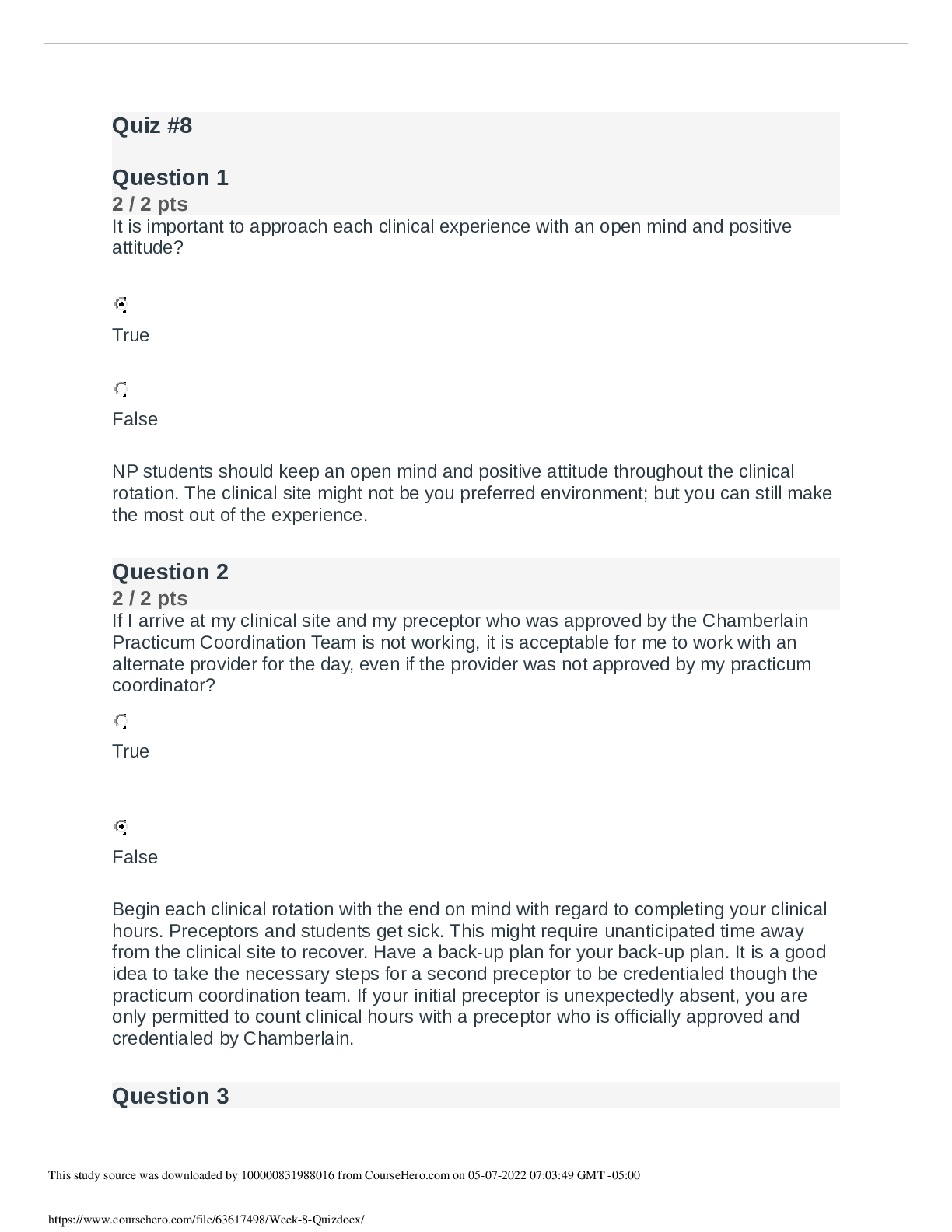



.png)
.png)
.png)
.png)

.png)


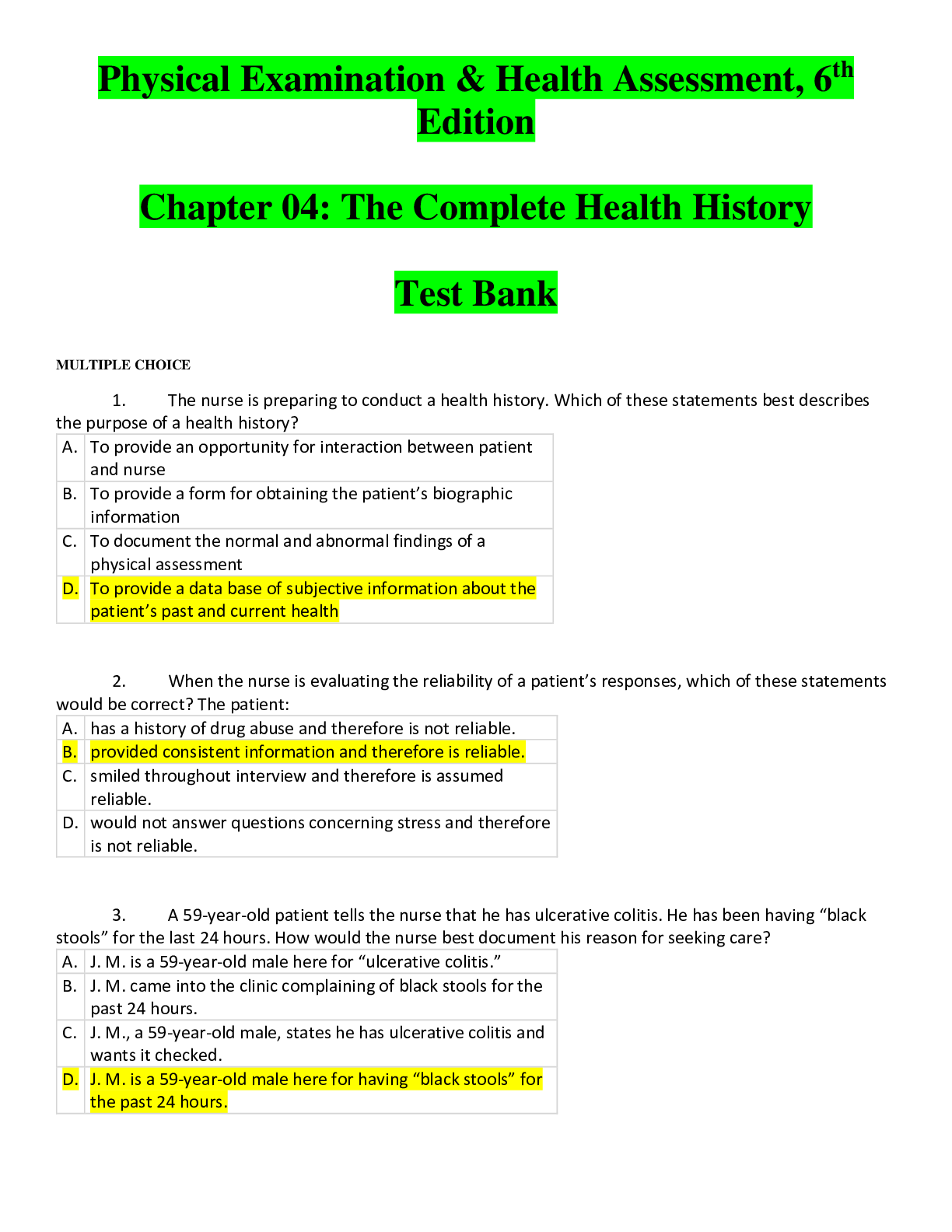
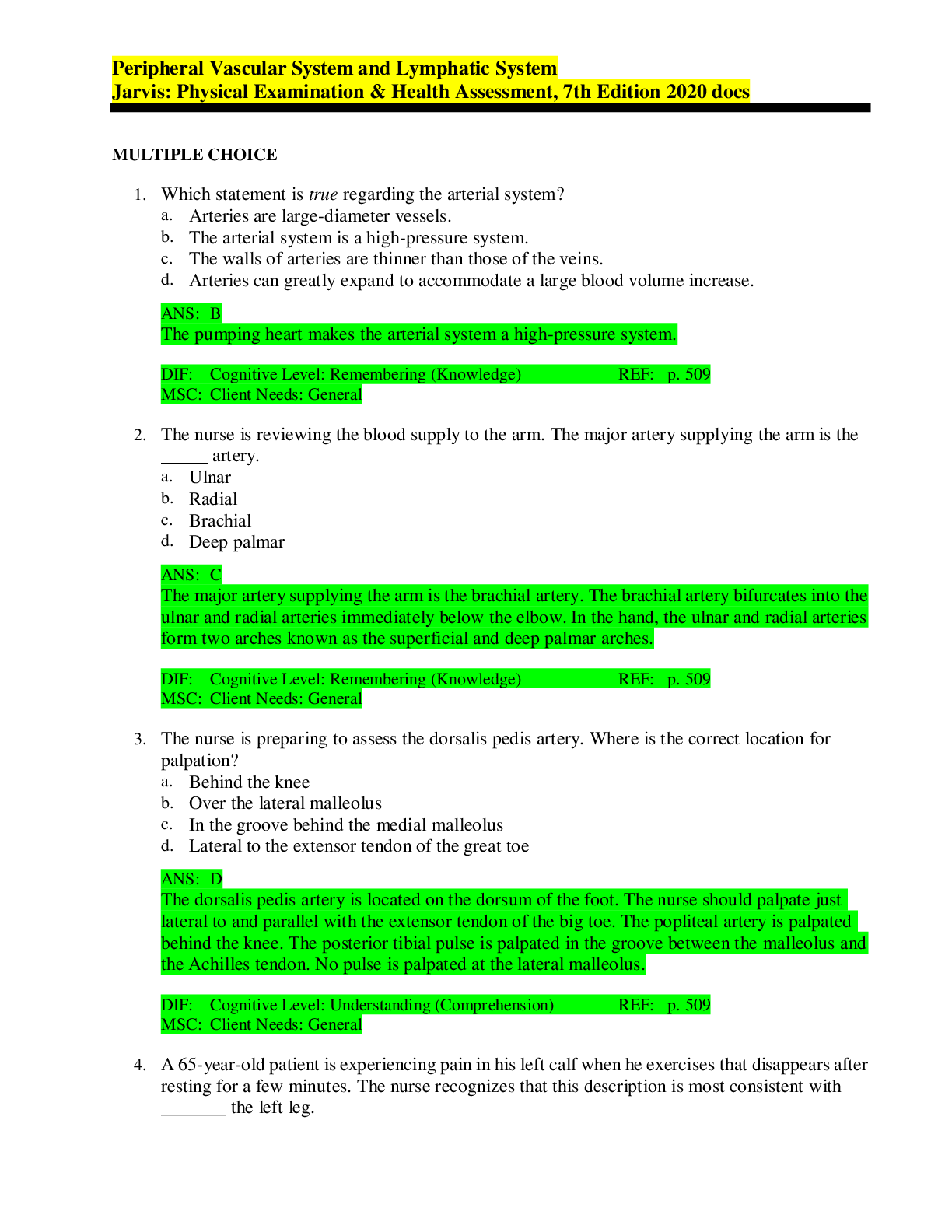
 answers.png)
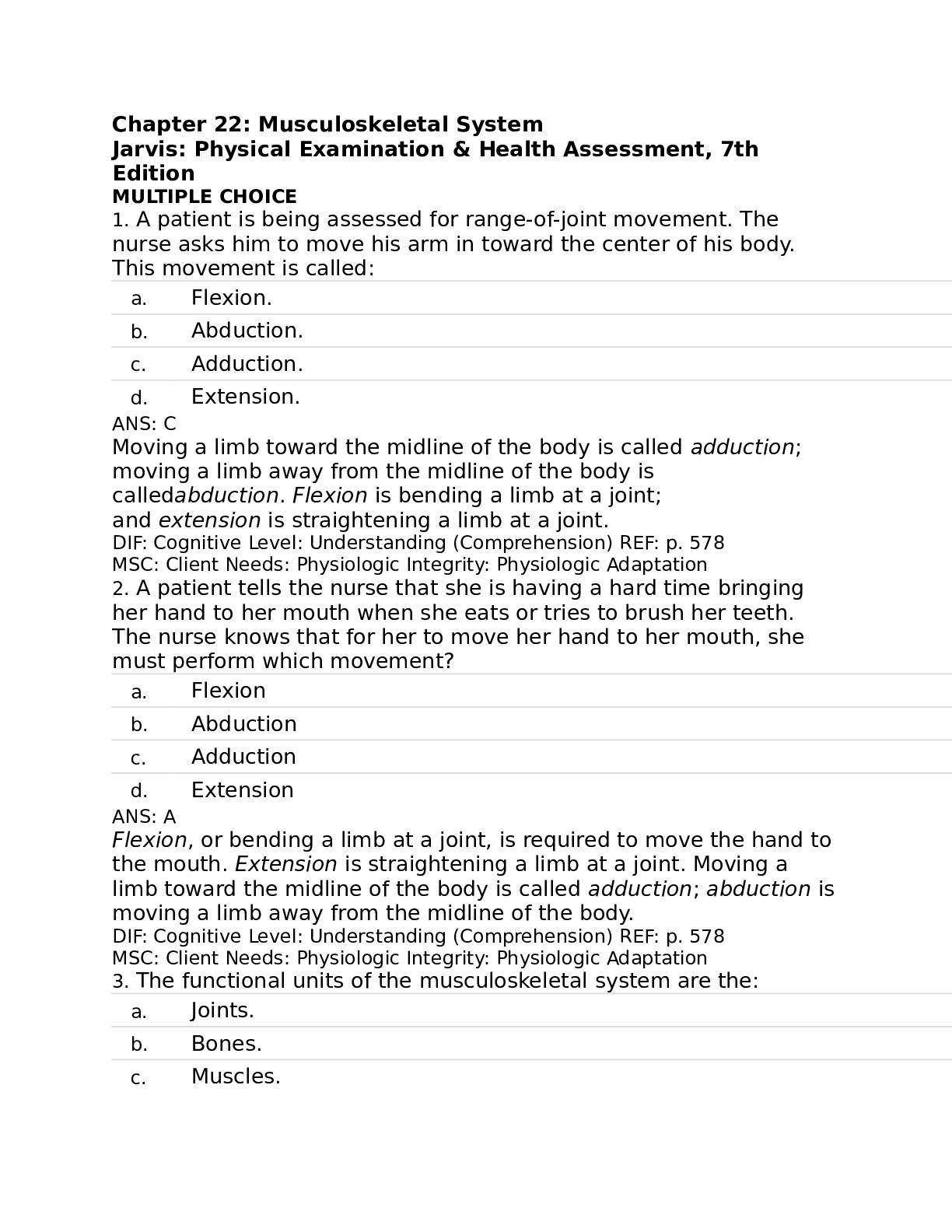
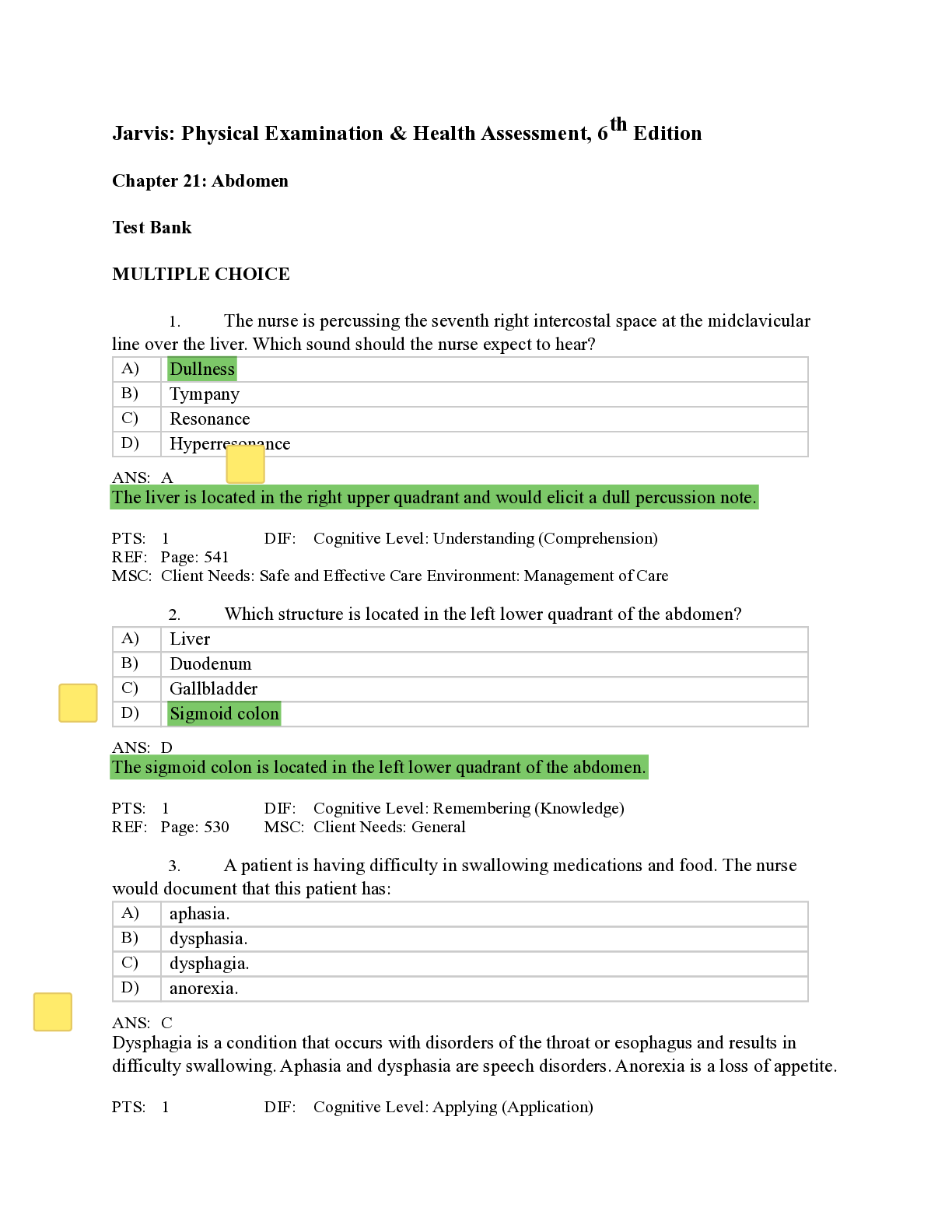
, Latest Questions and Answers with Explanations for Revision, All C.png)
, Latest Questions and Answers with Explanations for Revision, All Correct Latest Review, (La.png)
, Latest Questions and Answers with Explanations for Revision, All Correct Latest Review, (Latest 2021) Correc.png)
, Latest Questions and Answers with Explanations for Revision, All Correct Latest Revie.png)


